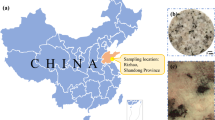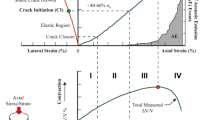Abstract
As one of the main means of non-destructive testing, ultrasonic waves can effectively detect damage inside rock, which provides an important basis for the evaluation of rock mechanical properties. This study investigates the ultrasonic characteristics of frozen sandstone during loading and the effect of different temperatures. Combined with the deformation and failure process of the frozen sandstone sample, variation in ultrasonic velocity, amplitude, frequency spectrum, quality factor, and energy during loading were analyzed. The results show that (1) the amplitude of ultrasonic first increased, then decreased, then increased again with the increase in axial stress (\(\sigma_{1}\)), and decreased with the decrease in temperature. (2) The amplitude and arrival time of the first wave decreased as the temperature decreased. The amplitude of the first wave increased with the increase in \(\sigma_{1}\), while the arrival time is reversed. (3) The ultrasonic velocity (\(v_{p}\)) increased as the temperature decreased. \(v_{p}\) increased rapidly in the compaction stage and increased slowly in the elastic stage. Before the peak stress, when the stress level of sandstone samples was 0.88–0.93, \(v_{p}\) reached its peak and then decreased rapidly due to the initiation and expansion of cracks. (4) The spectral peaks increased with the increase in \(\sigma_{1}\) and decreased with the decrease in temperature. In addition, the quality factor and accumulated energy of the ultrasonic increase first and then decrease during loading. The relationship between the ultrasonic velocity and stress of frozen sandstone at different temperatures was established using logarithmic function fitting.















Similar content being viewed by others
Data availability
The data that support the findings of this study are within the paper.
References
Abdi Y, Khanlari G-R, Jamshidi A (2018) Correlation between mechanical properties of sandstones and P-wave velocity in different degrees of saturation. Geotech Geol Eng. https://doi.org/10.1007/s10706-018-0721-6
Amalokwu K, Best AI, Sothcott J, Chapman M, Minshull T, Li XY (2014) Water saturation effects on elastic wave attenuation in porous rocks with aligned fractures. Geophys J Int 197(2):943–947. https://doi.org/10.1093/gji/ggu076
Ayling MR, Meredith PG, Murrell SFA (1995) Microcracking during triaxial deformation of porous rocks monitored by changes in rock physical properties, I. Elastic-wave propagation measurements on dry rocks. Tectonophysics 245(3–4):205–221. https://doi.org/10.1016/0040-1951(94)00235-2
Ba J, Ma RP, Carcione JM, Picotti S (2019) Ultrasonic wave attenuation dependence on saturation in tight oil siltstones. J Petrol Sci Eng 179:1114–1122. https://doi.org/10.1016/j.petrol.2019.04.099
Barnhoorn A, Verheij J, Frehner M, Zhubayev A, Houben M (2018) Experimental identification of the transition from elasticity to inelasticity from ultrasonic attenuation analyses. Geophysics 83(4):MR221-MR229. https://doi.org/10.1190/geo2017-0534.1
Cacqueray BD, Roux P, Campillo M, Catheline S, Boue P (2011) Elastic-wave identification and extraction through array processing: an experimental investigation at the laboratory scale. J Appl Geophys 74(2–3):81–88. https://doi.org/10.1016/j.jappgeo.2011.04.005
Chen J, Yin TY, Kim J-Y, Xu Z, Yao YP (2017) Characterization of thermal damage in sandstone using the second harmonic generation of standing waves. Int J Rock Mech Min Sci 91:81–89. https://doi.org/10.1016/j.ijrmms.2016.11.014
Ding ZF, Zhou XF, Wu Y, Li GY, Zhang H (2009) Tomographic imaging of P-wave velocity structure beneath the region around Beijing. Earthq Sci 22(4):403–408. https://doi.org/10.1007/s11589-009-0403-9
Dong XH, Yang GS, Liu S (2022) Experimental study on AE response and damage evolution characteristics of frozen sandstone under uniaxial compression. Cold Regions Sci Technol 193:103424. https://doi.org/10.1016/j.coldregions.2021.103424
Gao JW, Xu C, Xi Y, Fan LF (2021) Degradation of mechanical behavior of sandstone under freeze-thaw conditions with different low temperatures. Appl Sci 11(22):10653. https://doi.org/10.3390/app112210653
Goodfellow SD, Tisato N, Ghofranitabari M, Nasseri MHB, Young RP (2015) Attenuation properties of Fontainebleau sandstone during true-triaxial deformation using active and passive ultrasonics. Rock Mech Rock Eng 48(6):2551–2566. https://doi.org/10.1007/s00603-015-0833-8
Guo MQ, Ba J, Ma RP, Chen TS, Zhang L, Pang MQ, Xie JY (2018) P-wave velocity dispersion and attenuation in fluid-saturated tight sandstones: characteristics analysis based on a double double-porosity structure model description. Chin J Geophys 61(3):1053–1068. https://doi.org/10.6038/cjg2018L0678
Guo, Y., Li, G., Jia, C.Y., Chang, T.Y., Cui, H.L. and Alexey, M., 2016. Study of ultrasonic test in the measurements of mechanical properties of ice. Chinese J Polar Res 28(1):152–157. https://doi.org/10.13679/j.jdyj.2016.1.152
Huang S, Liu F, Li G, Yu S (2023) Estimation of the unfrozen water content of saturated sandstones by ultrasonic velocity. Int J Min Sci Technol. https://doi.org/10.1016/j.ijmst.2023.02.003
Jamshidi A, Torabi-Kaveh M (2021) Anisotropy in ultrasonic pulse velocity and dynamic elastic constants of laminated sandstone. Quart J Eng Geol Hydrogeol 54(3). https://doi.org/10.1144/qjegh2020-101
Jia HL, Ding S, Wang Y, Zi F, Yang GS (2019) An NMR-based investigation of pore water freezing process in sandstone. Cold Regions Sci Technol 168:102893. https://doi.org/10.1016/j.coldregions.2019.102893
Kang M, Lee JS (2015) Evaluation of the freezing-thawing effect in sand-silt mixtures using elastic waves and electrical resistivity. Cold Reg Sci Technol 113:1–11. https://doi.org/10.1016/j.coldregions.2015.02.004
Kim BC, Chen J, Kim J-Y (2020) Relation between crack density and acoustic nonlinearity in thermally damaged sandstone. Intern J Rock Mech Min Sci 125:104171. https://doi.org/10.1016/j.ijrmms.2019.104171
King MS (1977) Acoustic velocities and electrical properties of frozen sandstones and shales. Can J Earth Sci 14(5):1004–1013. https://doi.org/10.1139/e77-092
Lavrentyev AI, Rokhlin SI (2001) An ultrasonic method for determination of elastic moduli, density, attenuation and thickness of a polymer coating on a stiff plate. Ultrasonics 39(3):211–221. https://doi.org/10.1016/S0041-624X(00)00066-4
Li H, Xia X, Li J, Zhao J (2011) Rock damage control in bedrock blasting excavation for a nuclear power plant. Intern J Rock Mech Min Sci
Li HR, Yang CH, Li BL, Yin XY (2016) Damage evolution and characteristics of ultrasonic velocity and acoustic emission for salt rock under triaxial multilevel loading test. Chinese J Rock Mech Eng 35(4):682–691. https://doi.org/10.13722/j.cnki.jrme.2015.1069
Li HR, Yang CH, Liu YG, Chen F, Ma HL (2014) Experimental study of ultrasonic velocity and acoustic emission properties of salt rock under uniaxial compression load. Chinese J Rock Mech Eng 33(10):2107–2116. https://doi.org/10.13722/j.cnki.jrme.2014.10.018
Li XF, Li HB, Zhang GK (2019) Damage assessment and blast vibrations controlling considering rock properties of underwater blasting. Intern J Rock Mech Min Sci 121
Liu HH, Dou YK, Chang XM, Chen Y, Liu L, Zhou YX (2016) Experimental and simulation research on the propagation characteristics of ultrasonic wave in ice. J Taiyuan Univ Technol 47(3):373–378+383. https://doi.org/10.16355/j.cnki.issn1007-9432tyut.2016.03.018
Liu ZQ, Chen G (2001) Spectral analysis for ultrasonic nondestructive testing. Nondestructive Testing 23(2):85–88. https://doi.org/10.8991/j.cnki.nt.2001.02.018
Martínez-Martínez J, Benavente D, García-Del-Cura MA (2011) Spatial attenuation: the most sensitive ultrasonic parameter for detecting petrographic features and decay processes in carbonate rocks. Eng Geol 119(3–4):84–95. https://doi.org/10.1016/j.enggeo.2011.02.002
Mavko GM, Nur A (1979) Wave attenuation in partially saturated rocks. Geophysics 44(2):161–178. https://doi.org/10.1190/1.1440958
Pimienta L, Fortin J, Guéguen Y (2014) Investigation of elastic weakening in limestone and sandstone samples from moisture adsorption. Geophys J Intern (1):335–347. https://doi.org/10.1093/gji/ggu257
Prassianakis NI, Prassianakis IN (2004) Ultrasonic testing of non-metallic materials: concrete and marble. Theoret Appl Fract Mech 42(2):191–198. https://doi.org/10.1016/j.tafmec.2004.08.007
Shan RL, Bai Y, Ju Y, Han TY, Dou HY, Li ZL (2021) Study on the triaxial unloading creep mechanical properties and damage constitutive model of red sandstone containing a single ice-filled flaw. Rock Mech Rock Eng 54(2):833–855. https://doi.org/10.1007/s00603-020-02274-1
Shirole D, Hedayat A, Ghazanfari E, Walton G (2020) Evaluation of an ultrasonic method for damage characterization of brittle rocks. Rock Mech Rock Eng 53(5):2077–2094. https://doi.org/10.1007/s00603-020-02045-y
Sondergeld CH, Rai CS (2007) Velocity and resistivity changes during freeze-thaw cycles in Berea sandstone. Geophysics 72(2):E99–E105. https://doi.org/10.1190/1.2435198
Sun YJ, Zuo JP, Shi Y, Li ZD, Mi CN, Wen JH (2021) Experimental investigation on the correlation between dynamic ultrasonic and mechanical properties of sandstone subjected to uniaxial compression. Geofluids 2021(10):1–22. https://doi.org/10.1155/2021/5578591
Torabi A, Zarifi Z (2014) Energy release rate of propagating deformation bands and their hosted cracks. Int J Rock Mech Min Sci 67:184–190. https://doi.org/10.1016/j.ijrmms.2013.10.007
Wang L, Rybacki E, Bonnelye A, Bohnhoff M, Dresen G (2021) Experimental investigation on static and dynamic bulk moduli of dry and fluid-saturated porous sandstones. Rock Mech Rock Eng 54(1):129–148. https://doi.org/10.1007/s00603-020-02248-3
Wang P, Xu JY, Fang XY, Wang PX, Zheng GH, Wen M (2017) Ultrasonic time-frequency method to evaluate the deterioration properties of rock suffered from freeze-thaw weathering. Cold Reg Sci Technol 143:13–22. https://doi.org/10.1016/j.coldregions.2017.07.002
Wang P, Xu JY, Liu S (2015a) Staged Moduli: a quantitative method to analyze the complete compressive stress–strain response for thermally damaged rock. Rock Mech Rock Eng 48(4):1505–1514. https://doi.org/10.1007/s00603-014-0648-z
Wang P, Xu JY, Liu S (2015b) Ultrasonic method to evaluate the residual properties of thermally damaged sandstone based on time–frequency analysis. Nondestructive Testing and Evaluation 30(1):74–88. https://doi.org/10.1080/10589759.2014.1002838
Yang H, Duan H, Zhu J (2023) Experimental study on the role of clay mineral and water saturation in ultrasonic P-wave behaviours across individual filled rock joints. Intern J Rock Mech Min Sci 168:105393. https://doi.org/10.1016/j.ijrmms.2023.105393
Yang H, Duan HF, Zhu J (2019) Ultrasonic P-wave propagation through water-filled rock joint: an experimental investigation. J Appl Geophys 169:1–14. https://doi.org/10.1016/j.jappgeo.2019.06.014
Yang L, Jia HL, Han L, Zhang HM, Tang LY (2021) Hysteresis in the ultrasonic parameters of saturated sandstone during freezing and thawing and correlations with unfrozen water content. Journal of Rock Mechanics and Geotechnical Engineering 13(5):1078–1092
Yang S, Zhang N, Feng XW, Kan JG, Pan DJ, Qian DY (2018) Experimental investigation of sandstone under cyclic loading: damage assessment using ultrasonic wave velocities and changes in elastic modulus. Shock Vibration 2018:7845143. https://doi.org/10.1155/2018/7845143
Yin DH, Xu QJ (2020) Comparison of sandstone damage measurements based on non-destructive testing. Materials 13(22):5154. https://doi.org/10.3390/ma13225154
Zhang L, Zhang ZT, Zhang R, Gao MZ, Xie J (2021) The ultrasonic P-wave velocity-stress relationship and energy evolution of sandstone under uniaxial loading-unloading conditions. Adv Mater Sci Eng 2021:9921716. https://doi.org/10.1155/2021/9921716
Zhang Z, Zhu J, Deng J (2022) A comparative study for determining rock joint normal stiffness with destructive uniaxial compression and nondestructive ultrasonic wave testing. Journal of Rock Mechanics and Geotechnical Engineering 10:010. https://doi.org/10.1016/j.jrmge.2022.10.010
Zhang ZH, Jiang QH, Zhou CB, Liu XT (2014) Strength and failure characteristics of Jurassic Red-Bed sandstone under cyclic wetting-drying conditions. Geophys J Int 198(2):1034–1044. https://doi.org/10.1093/gji/ggu181
Funding
This work was supported by the National Natural Science Foundation of China (No. 41702339 and 52274137) and the Key Scientific and Technological Innovation Team Program Funds for Shaanxi Province (No. 2016KCT-13).
Author information
Authors and Affiliations
Corresponding author
Ethics declarations
Conflict of interest
The authors declared no competing interests.
Rights and permissions
Springer Nature or its licensor (e.g. a society or other partner) holds exclusive rights to this article under a publishing agreement with the author(s) or other rightsholder(s); author self-archiving of the accepted manuscript version of this article is solely governed by the terms of such publishing agreement and applicable law.
About this article
Cite this article
Dong, X., Liu, S. & Jia, H. Experimental study on ultrasonic characteristics of frozen sandstone under uniaxial compression. Bull Eng Geol Environ 82, 352 (2023). https://doi.org/10.1007/s10064-023-03343-9
Received:
Accepted:
Published:
DOI: https://doi.org/10.1007/s10064-023-03343-9




